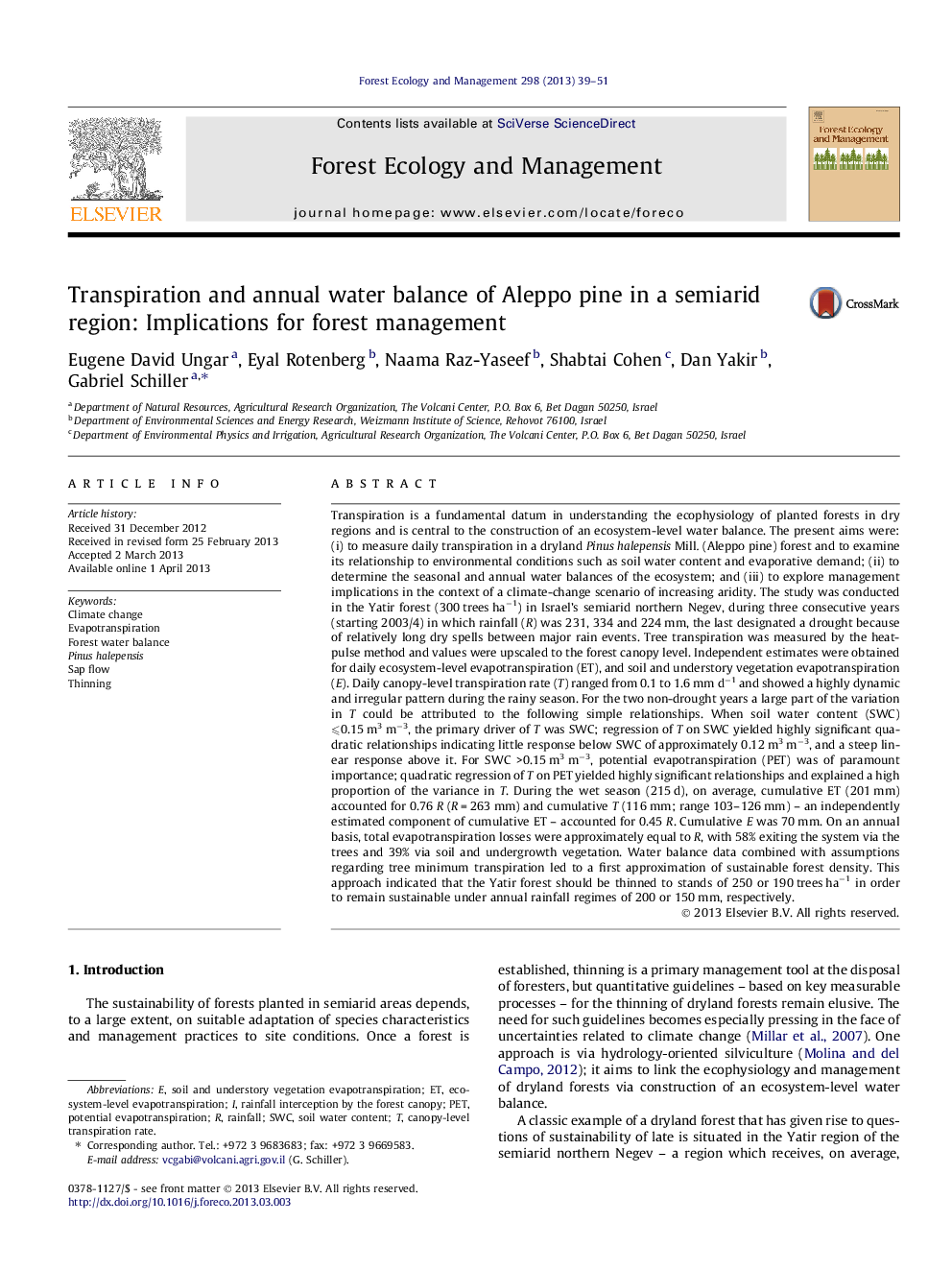| کد مقاله | کد نشریه | سال انتشار | مقاله انگلیسی | نسخه تمام متن |
|---|---|---|---|---|
| 86836 | 159216 | 2013 | 13 صفحه PDF | دانلود رایگان |

• We studied Aleppo pine transpiration (T) in a dryland forest during three seasons.
• Soil water content (SWC) was the primary determinant of T when SWC < 0.15 m3 m−3.
• Potential evapotranspiration was the main determinant of T above this level of SWC.
• 58 and 39% of rainfall exited the system via the trees and soil, respectively.
• A water-balance approach was developed to estimate sustainable forest density.
Transpiration is a fundamental datum in understanding the ecophysiology of planted forests in dry regions and is central to the construction of an ecosystem-level water balance. The present aims were: (i) to measure daily transpiration in a dryland Pinus halepensis Mill. (Aleppo pine) forest and to examine its relationship to environmental conditions such as soil water content and evaporative demand; (ii) to determine the seasonal and annual water balances of the ecosystem; and (iii) to explore management implications in the context of a climate-change scenario of increasing aridity. The study was conducted in the Yatir forest (300 trees ha−1) in Israel’s semiarid northern Negev, during three consecutive years (starting 2003/4) in which rainfall (R) was 231, 334 and 224 mm, the last designated a drought because of relatively long dry spells between major rain events. Tree transpiration was measured by the heat-pulse method and values were upscaled to the forest canopy level. Independent estimates were obtained for daily ecosystem-level evapotranspiration (ET), and soil and understory vegetation evapotranspiration (E). Daily canopy-level transpiration rate (T) ranged from 0.1 to 1.6 mm d−1 and showed a highly dynamic and irregular pattern during the rainy season. For the two non-drought years a large part of the variation in T could be attributed to the following simple relationships. When soil water content (SWC) ⩽0.15 m3 m−3, the primary driver of T was SWC; regression of T on SWC yielded highly significant quadratic relationships indicating little response below SWC of approximately 0.12 m3 m−3, and a steep linear response above it. For SWC >0.15 m3 m−3, potential evapotranspiration (PET) was of paramount importance; quadratic regression of T on PET yielded highly significant relationships and explained a high proportion of the variance in T. During the wet season (215 d), on average, cumulative ET (201 mm) accounted for 0.76 R (R = 263 mm) and cumulative T (116 mm; range 103–126 mm) – an independently estimated component of cumulative ET – accounted for 0.45 R. Cumulative E was 70 mm. On an annual basis, total evapotranspiration losses were approximately equal to R, with 58% exiting the system via the trees and 39% via soil and undergrowth vegetation. Water balance data combined with assumptions regarding tree minimum transpiration led to a first approximation of sustainable forest density. This approach indicated that the Yatir forest should be thinned to stands of 250 or 190 trees ha−1 in order to remain sustainable under annual rainfall regimes of 200 or 150 mm, respectively.
Journal: Forest Ecology and Management - Volume 298, 15 June 2013, Pages 39–51